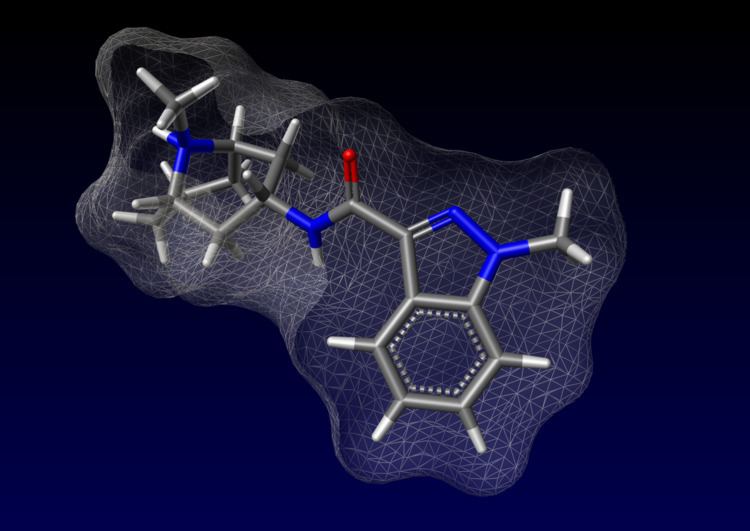AHFS/Drugs.com Monograph Pregnancycategory AU: B1 Molar mass 312.41 g/mol Bioavailability 60% | MedlinePlus a601211 ATC code A04AA02 (WHO) CAS ID 109889-09-0 Protein binding 65% | |
 | ||
Trade names Kytril, Sancuso, others Routes ofadministration by mouth, intravenous, transdermal | ||
Granisetron is a serotonin 5-HT3 receptor antagonist used as an antiemetic to treat nausea and vomiting following chemotherapy. Its main effect is to reduce the activity of the vagus nerve, which is a nerve that activates the vomiting center in the medulla oblongata. It does not have much effect on vomiting due to motion sickness. This drug does not have any effect on dopamine receptors or muscarinic receptors.
Contents
Granisetron was developed by chemists working at the British drug company Beecham around 1988 and is available as a generic. It is produced by Roche Laboratories under the trade name Kytril. The drug was approved in the United Kingdom in 1991 and in United States in 1994 by the FDA.
A granisetron transdermal patch with the trade name Sancuso was approved by the US FDA on September 12, 2008. Sancuso is manufactured by 3M Drug Delivery Systems Division in St. Paul, MN, for ProStrakan, Inc., a pharmaceutical company headquartered in Bedminster, NJ, with global headquarters in Scotland.
Granisetron is metabolized slowly by the liver, giving it a longer than average half-life. One dose usually lasts 4 to 9 hours and is usually administered once or twice daily. This drug is removed from the body by the liver and kidneys.
Chemotherapy
It may be used for chemotherapy-induced nausea and vomiting and appears to work about the same as ondansetron. The most common side-effects of chemotherapy treatment are nausea, vomiting and diarrhea. This is one type of drug that a doctor can prescribe to prevent, lessen, or relieve discomfort.
Post operative
A number of medications including granisetron appear to be effective in controlling post-operative nausea and vomiting (PONV). It is unclear if it is more or less effective than other agents such as droperidol, metoclopramide, ondansetron or cyclizine.
Its efficacy has also been questioned with a research Dr. Yoshitaka Fujii having 12 published papers on this topic in Canadian Journal of Anesthesia retracted. A further five papers in the same journal on the same drug by Dr Fujii are considered indeterminate.
Other
Adverse effects
Granisetron is a well-tolerated drug with few side effects. Headache, dizziness, and constipation are the most commonly reported side effects associated with its use. There have been no significant drug interactions reported with this drug's use. It is broken down by the liver's cytochrome P450 system and it has little effect on the metabolism of other drugs broken down by this system.
Extended release
An extended release injectable version of granisetron, known as Sustol is also available in the United States as of 2016. The long acting form is used for the treatment of both acute and delayed CINV in moderately emetogenic chemotherapy and anthrocycline and/or cyclophosphamide (AC) highly emetogenic regimens. In its review, the FDA did not grant the broad HEC label to the drug citing the focus on AC regimens, primarily breast-cancer, and lack of data.
